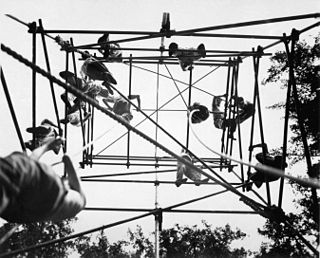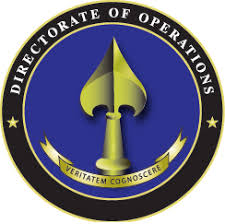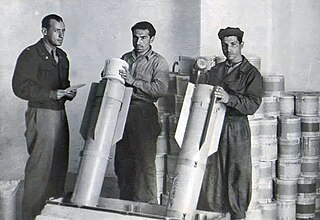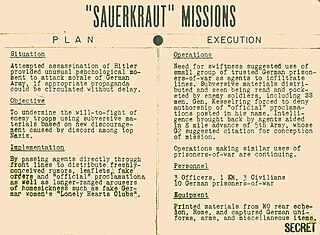 W
WThe Office of Strategic Services (OSS) was a wartime intelligence agency of the United States during World War II, and a predecessor to the Department of State's Bureau of Intelligence and Research (INR) and the Central Intelligence Agency (CIA). The OSS was formed as an agency of the Joint Chiefs of Staff (JCS) to coordinate espionage activities behind enemy lines for all branches of the United States Armed Forces. Other OSS functions included the use of propaganda, subversion, and post-war planning. On December 14, 2016, the organization was collectively honored with a Congressional Gold Medal.
 W
WThe BEANO T-13 hand grenade was an experimental Hand Grenade developed by the Office of Strategic Services, with assistance from Eastman Kodak Corporation, in the latter years of World War II.
 W
WOperation Claw was a joint Swedish–American operation, with Norwegian support, that was carried out at Lillehammer shortly after the German capitulation by the end of World War II. Thirty-five German intelligence specialists were transferred along with various equipment first to Sweden and then to U.S. camps in occupied Germany through an agreement between the Americans and the German High Command of the Wehrmacht in Norway.
 W
WOperation Cornflakes was a morale operation by the Office of Strategic Services during World War II that aimed to trick Deutsche Reichspost into inadvertently delivering anti-Nazi propaganda to German citizens through mail.
 W
WDas Neue Deutschland was an alleged freedom movement that was founded by the American Office of Strategic Services (OSS) in June 1944 during the Second World War. Its main organ was a magazine of the same name, which was brought to Germany by resistance fighters, former German prisoners of war, and with the help of airplanes. The aim was to create the impression, through propagandistic articles in this magazine, that an underground movement existed on the territory of the German Reich with the intention of overthrowing the Nazi regime. In the editorial design of the magazine, care was taken to ensure that, as far as possible, no reference to hostile propaganda was discernible; it was imperative to convey the idea of an opposition independent of the Allies that existed within Germany. In order to find a meaningful name for the journal, the planning group asked for more than 30 suggestions, all of which, however, turned out to be unsuitable. Either they were names that had already been used during the Weimar Republic and thus had negative connotations, or they were names of smaller local splinter groups that had been used earlier. Since the magazine was intended to convey the idea of a new Germany after the Nazi dictatorship, the final name was eventually agreed upon, which had never been used in the past either.
 W
WThe OSS Deer Team was established by the United States Office of Strategic Services on May 16, 1945 to attack and intercept materials on the railroad from Hanoi in central Vietnam to Lạng Sơn in northeast Vietnam with the hope of keeping Japanese military units from entering China. They sent intelligence reports to OSS agents stationed in China. The team provided training, medical and logistical assistance to Hồ Chí Minh and the Việt Minh in 1945.
 W
WOperation Jedburgh was a clandestine operation during World War II, in which personnel of the British Special Operations Executive (SOE), the U.S. Office of Strategic Services (OSS), the Free French Bureau Central de Renseignements et d'Action and the Dutch and Belgian armies in exile were dropped by parachute into occupied France, the Netherlands and Belgium to conduct sabotage and guerrilla warfare, and to lead the local resistance forces in actions against the Germans.
 W
WRené Joyeuse, M.D., MS, FACS was a Swiss, French and American soldier, physician and researcher, who distinguished himself as an agent of Allied intelligence in German-occupied France during World War II.
 W
WThe Special Activities Center (SAC) is a division of the Central Intelligence Agency responsible for covert operations and paramilitary operations. The unit was named Special Activities Division (SAD) prior to 2016. Within SAC there are two separate groups: SAC/SOG for tactical paramilitary operations and SAC/PAG for covert political action.
 W
WOperation Pig Iron was a secret service measure planned and carried out by the American Office of Strategic Services (OSS) from the summer of 1944 onwards during the Second World War. The aim was to indoctrinate the enemy by using "bombs" containing miniature editions of the propaganda magazine Das Neue Deutschland. These bombs were dropped by plane over enemy territory. With more than 8.9 million printed copies of the journal, the miniature edition was the most massive way of distributing this propaganda tool.
 W
WOperation Paperclip was a secret program of the Joint Intelligence Objectives Agency (JIOA) largely carried out by special agents of Army CIC, in which more than 1,600 German scientists, engineers, and technicians, such as Wernher von Braun and his V-2 rocket team, were taken from Germany to the United States, for U.S. government employment, primarily between 1945 and 1959. Many were former members, and some were former leaders, of the Nazi Party.
 W
WThe Sauerkraut missions were secret service operations planned and carried out by the American Office of Strategic Services (OSS) during the Second World War from July 1944 to at least March 1945. The aim was to enable rapid dissemination of Allied propaganda material by the use of German prisoners of war.
 W
WUndercover, also known as Undercover: How to Operate Behind Enemy Lines and How to Operate Behind Enemy Lines, is a 1943 Office of Strategic Services training film, directed by and featuring John Ford. It was edited by Ford's longtime collaborator Robert Parrish.